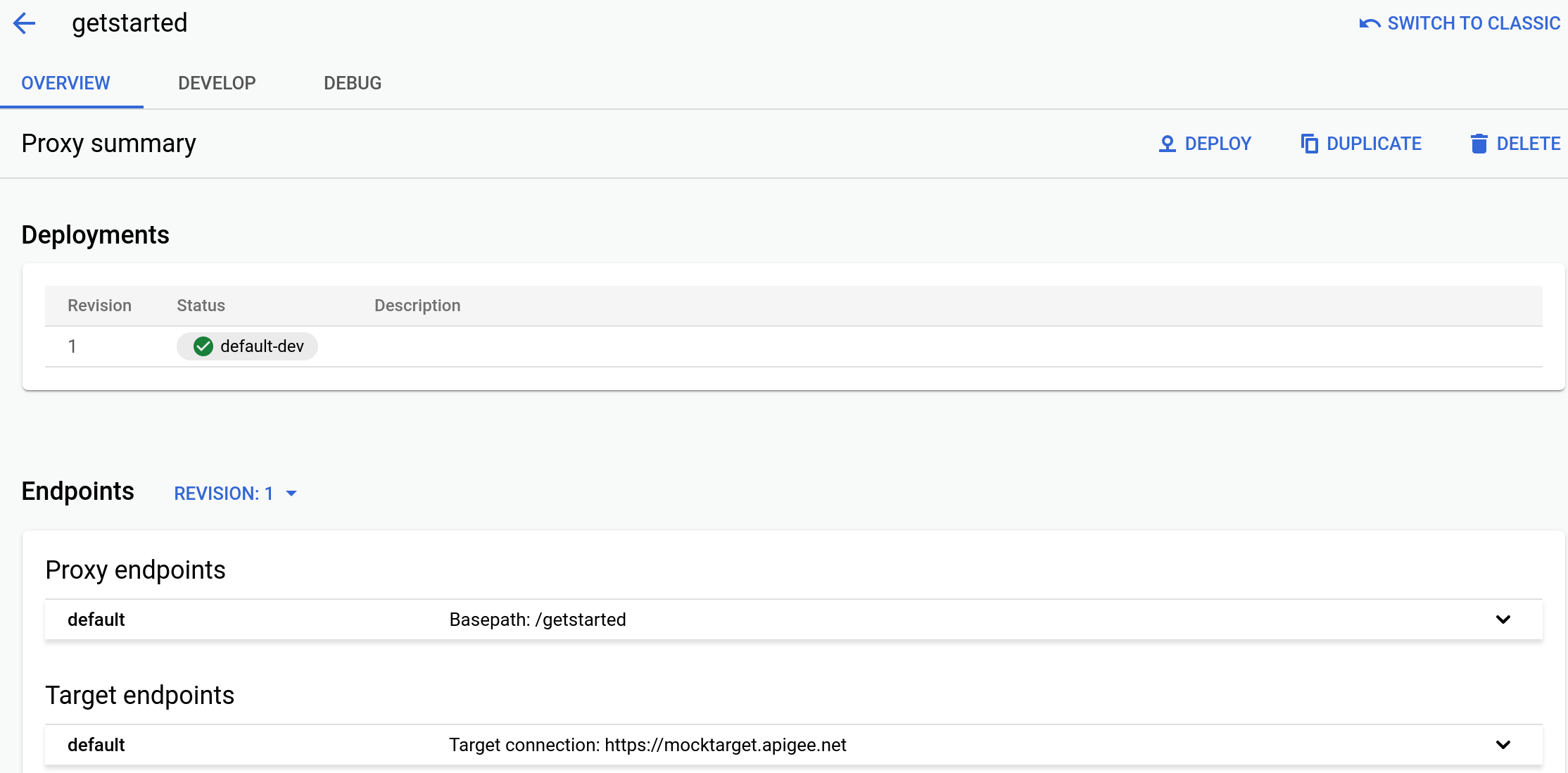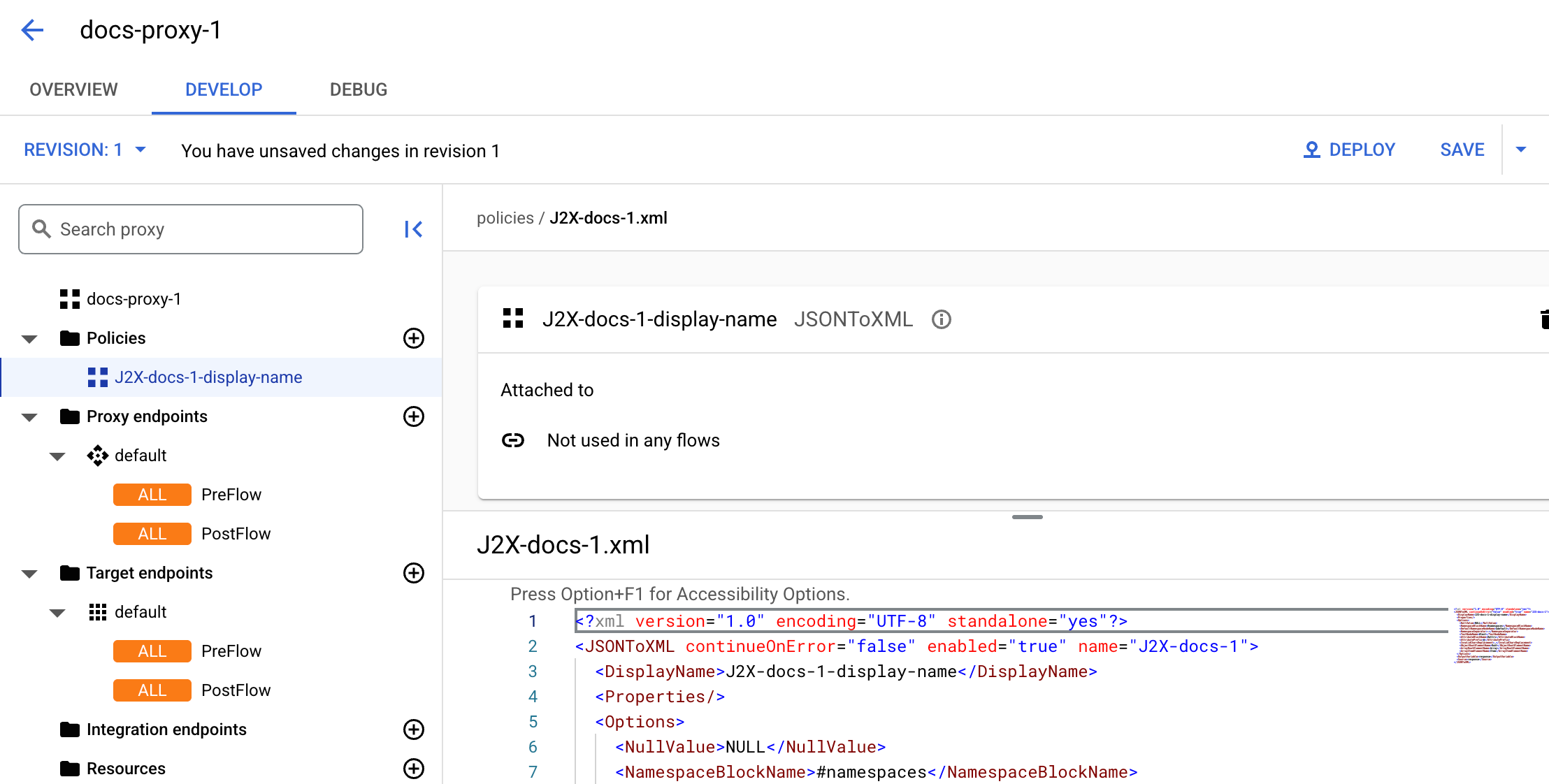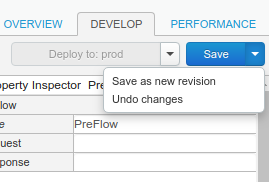This page applies to Apigee and Apigee hybrid.
View
Apigee Edge documentation.
![]()
Use the Apigee UI or API to edit an API proxy. Editing an API proxy can include configuring policies, configuring proxy endpoints, target endpoints, and integration endpoints, adding or removing flow hooks, and deploying the proxy.
When you edit an API proxy, you can decide which of the following to do with the resulting changes:
- Save your changes on the server but do not create a new revision. You do this when you do not
want to deploy your saved changes, but just want to ensure that they are not lost if you end the
session.
OR
- Create a new API proxy revision and deploy it to the cluster. You cannot deploy changes to an API proxy without creating a new revision of it.
Apigee in Cloud console
To edit an API proxy and save your changes using the Apigee Cloud console:
In the Google Cloud console, go to the Proxy development > API proxies page.
Select the proxy that you want to edit from the list of proxies. The UI displays the Overview tab for that proxy in the Google Cloud console.

- Click the Develop tab to make your changes to the proxy.
For example, to add a policy, click the + icon next to Policies, select the policy to add, enter a name and an optional display name, click Create, and configure the policy in the interface.
- When you are done making changes, you
can do one of the following:
- To save your changes but not create a new revision, click the Save button. (You should do this periodically to ensure that your changes are not lost if you end the session).
- To save your changes as a new revision (when you are getting ready to deploy and test),
click the drop-down menu next to
the Save button and select Save as new revision:

The Apigee UI saves your changes and generates a new revision of the proxy for you. It does not deploy the new bundle to the runtime; you must explicitly do that, as described in Deploying an API proxy.
Classic Apigee
To edit an API proxy and save your changes using the classic Proxy Editor:
- Sign in to the Apigee UI.
- Click API Proxies in the main view.
Alternatively, you can select Develop > API Proxies in the left navigation menu.
Select the environment that contains the proxy you want to edit.
The Apigee UI displays a list of API proxies for the selected environment:

- Click the proxy that you want to edit. The UI displays the Overview tab for
that proxy in the Proxy Editor:

- Click the Develop tab in the upper right of the view.
- Use the proxy editor to make your changes to the proxy. When you are done making changes, you
can do one of the following:
- Save your changes but do not create a new revision (most common; you should do this periodically to ensure that your changes are not lost if you end the session).
- Save your changes as a new revision (when you are getting ready to deploy and test).
- To save but not create a new revision, click Save
in the upper right of the UI:

The Apigee UI saves your changes so that you can leave the page and resume working later.
- To save your changes as a new revision, click the drop-down arrow next to
Save and select Save as new revision:

The Apigee UI saves your changes and generates a new proxy bundle for you. It does not deploy the new bundle to the runtime; you must explicitly do that, as described in Deploying an API proxy.
The UI displays a New revision saved message:

After you create a new revision, you typically deploy it to your cluster, as described in Deploying an API proxy.
Apigee API
Edit an API proxy to create a revision in your Apigee organization by issuing a POST
request to the following resource:
https://apigee.googleapis.com/v1/organizations/$ORG/apis
You must define the name of the API proxy using the name query parameter. Restrict
the characters used in the name to the following: A-Za-z0-9._\-$ %
Optionally, you can import an API proxy configuration bundle by performing the following steps:
- Set the
actionquery parameter toimport - Set the
Content-typeheader tomultipart/form-data - Pass the name of the API proxy configuration bundle on your local file system
The following example demonstrates how to edit an API proxy by importing an API proxy
configuration bundle (helloworld-config.zip) on your local file system using the
API.
export TOKEN=$(gcloud auth print-access-token) export ORG=ORGANIZATION_NAME curl "https://apigee.googleapis.com/v1/organizations/$ORG/apis?name=helloworld&action=import" \ -X POST \ -H "Authorization: Bearer $TOKEN" \ -H "Content-type: multipart/form-data" \ -F "file=@helloworld-config.zip"
Where $TOKEN is set to your OAuth 2.0 access token, as described in
Obtaining an OAuth 2.0 access token. For information about the curl options used in this example, see
Using curl. For a description of environment variables you can use, see
Setting
environment variables for Apigee API requests.
The following provides an example of the response output:
{ "basepaths": [ "/helloworld" ], "configurationVersion": { "majorVersion": 4 }, "createdAt": "1559145292799", "displayName": "helloworld", "entityMetaDataAsProperties": { "bundle_type": "zip", "subType": "Proxy", "lastModifiedAt": "1559145292799", "createdAt": "1559145292799" }, "lastModifiedAt": "1559145292799", "name": "helloworld", "policies": [ "verify-api-key", "remove-query-param-apikey", "OAuth-v20-1" ], "proxies": [ "default" ], "proxyEndpoints": [ "default" ], "resourceFiles": {}, "targetEndpoints": [ "default" ], "targets": [ "default" ], "type": "Application", "revision": "1", "description": "Hello world" }
For more information on editing an API proxy, see the apis.create method
in the Apigee API. To see all the methods available for API proxies, see the API proxies API.
